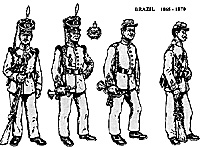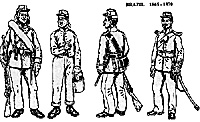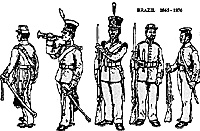Other Installments:
-
Imperial Brazilian Uniforms (Part 1): Line Infantry
Imperial Brazilian Uniforms (Part 2): Line Cavalry
Imperial Brazilian Uniforms (Part 3): Artillery
Imperial Brazilian Uniforms (Part 4): General Staff and Engineers
Imperial Brazilian Uniforms (Part 6): Guardia Nacional
As mentioned in Part 1 of this series the limited number of regular troops led to the various provinces raising their own troops for local defence. These corps initially answered to no authority above that of local government and, as a result, their organizations, designations and functions varied widely. During the 1850's these semi- independent local corps began increasingly to be drawn into the orbit of the regular army establishment. Being already in place, they were to function as local garrison forces, precluding the necessity of stationing regulars for that purpose.
The year 1860 saw a major reorganization of these "fixed" forces, all existing infantry corps being redesignated as "Cacadores", at the same time all "Pedestre" corps were ordered abolished. Following the Paraguayan invasion of Matto Grosso province in 1865, many of these corps were, of necessity, pressed into service to try to hold the breach until the army could be mobilized. In the course of the reorganization and expansion of the army in 1866 these local corps were abolished, generally being used as the nucleus for new formations.
"Barroso" gives histories of most of these local corps; I'll settle for quoting 2 or 3 to give a general idea:
MATTO GROSSO
The local forces were descended from a Legion of Matto Grosso existing toward the end of the 18th century. Following the War of Independence existing local forces were reorganised as a corps of "Ligeiros" ("Lights"). In 1832 this force was organized into 5 companies of Cacadores, 2 of Artillery and 1 of Marine Artillery. In 1840 the province raised a company of cavalry and the artillery companies were combined into a battalion of 465 men. In 1842 this force was officially designated as a "Fixed Corps", auxiliary to the army; a company of "Pedestres" (which would translate, very roughly, as "walkers" or "those who go on foot") was added, and the artillery battalion was taken onto the regular army line as the 4th Battalion of Foot Artillery.
In 1843 a new artillery battalion was formed and the entire force was organized as two "Fixed Corps": the 1st of 4 companies of Cacadores, 2 of artillery, 1 of cavalry and 1 of artificers (total - 768 men); the 2nd comprising 2 companies of Cacadores and 2 of artillery (438 men). Somewhat later, this force was rationalised as 2 equal corps of Cacadores of 6 companies each, an artillery corps of 4 companies, an artificer company, and a squadron of cavalry.
The general reform of the Fixed Corps in 1851 saw the reorganization of the Cacadores into a single battalion and the cavalry into a "half-regiment", the artillery remaining unchanged. At the tine of the Paraguayan invasion in 1865, the local fixed corps totalled, on paper, 1,327 men; in reality only about 600 could be gathered to defend the province. The Artillery corps, assisted by indians and local volunteers, defended the fortress of Coimbra. The Cacador battalion, assisted by local National Guards and volunteers, held the line of the Rio Apa for some weeks, while the 130 cavalrymen under Lt. Colonel Antonio Dias conducted a holding action around Nioac and along the line of the Rio Feio. Eventually, in the face of overwhelming numbers, the remainder of the corps formed a nucleus around which local refugees and National Guards could coalesce, to conduct a fighting retreat to Laguna.
GOYAZ:
In 1824-25 a corps of militia was formed to replace the ancient (and almost useless) corps of "Ordenancas" dating back to the 17th century. An order of 1831 abolished the heterogeneous assortment of militias, Ordenancas and Municipal guards forming the then existing reserve forces. By 1839 the province had a company of 100 "Ligeiros", reduced to just 39 men two years later. In 1841 there was a "Fixed Corps" of 1 company of Cacadores; expanded to 2 companies, plus a company of cavalry, the following year. In 1850, the above force having "disappeared" in the meantime, the government raised a new company of Cacadores. With the general reform of 1860 this was expanded to a battalion of Cacadores and a company of cavalry. Following the outbreak of war with Paraguay this force was sent to Sao Paulo to take part in a projected invasion of enemy territory. While there, due to a shortage of horses, the cavalry company was combined with dismounted cavalry from Sao Paulo and Minas Geraes Provinces to form a battalion of foot Cacadores, which was later taken onto the line as the 20th line Infantry.
MINAS GERAES: Initially local defense of Minas province was in the hands of the "Divisions of Rio Doce", established in 1820 to defend the local populace against the attacks of hostile indians, and totalling 268 men. In 1840 this force was retitled "Cacadores de Montanha", and expanded by 2 companies of "Pedestres", to which were added a company of cavalry and 2 of Cacadores in 1851. In 1860, following the general abolition of "Pedestres" units, the local "Fixed Corps" comprised a battalion of 4 companies of Cacadores and a cavalry company. On the outbreak of war with Paraguay the Cacador battalion was accepted into the "Voluntarios da Patria" organization as the 17th Corps of Volunteers, taking part in the expedition to retake Matto Grosso province. The history of the cavalry company is noted above under Goyaz province.
These "Fixed Corps" appear for the first time in army dress regulations in 1852, their uniforms formerly having been determined by local authorities. The 1852 uniforms followed much the same patterns as other army units, but tended to be simpler. They were never authorized the coatee, but instead wore the tunic for all orders of dress; initially the full dress tunic had the entire collar and round cuffs of the authorized provincial facing colour(s), the "second" or undress tunic having collar patches and 3-button cuff flaps as used by other corps. From 1856 The flapped cuff was authorised for all orders of dress, the full dress tunic continuing to be distinguished by a full facing colour collar and the "second" tunic by collar patches. The full dress headgear was the low bell-crowned shako as used by other corps, with a brass frontal device comprising the provincial initial or initials surrounded by a wreath with imperial crown above; plumes were of branch colour: green for Cacadores, red for cavalry and black tipped red for artillery. Undress headgear was initially a small round cap, later replaced by the kepi. Other items of uniform were much the same as those in use by the rest of the army.
The various provincial corps were to be distinguished by the colours of their collars, cuffs and piping. "Barroso" quotes a list of these distinctions according to the 1852 dress regulations:
CACADORES
Matto Grosso province - green collar, red cuffs and piping; Bahia - red collar, dark blue cuffs, green piping; Piauhy - dark blue collar, yellow cuffs, green piping;
Ceará - yellow collar, dark blue cuffs, green piping; Sao Paulo - light blue collar and cuffs, red piping; Minas Geraes - dark blue collar and cuffs, green piping; Goyaz - red collar, cuffs and piping; Rio Grande do Norte - dark blue collar and piping, green cuffs; Espirito Santo - green collar and piping, dark blue cuffs; Parahyba - green collar, dark blue cuffs and piping; Sergipe - dark blue collar, green cuffs and piping; Pernambuco - red collar and cuffs, dark blue piping.
CAVALRY
Matto Grosso - red collar, cuffs and piping; Bahia - red collar, dark blue cuffs, green piping; Minas Geraes and Sao Paulo - light blue collar, dark blue cuffs, red piping; Goyaz - red collar and piping, dark blue cuffs; Pernambuco - dark blue collar and piping, red cuffs.
On the "second" tunic, the collar patches would be of the colour of the full dress collar, and the cuff flaps of the full dress cuff colour. These distinctions varied a bit over the years as new provincial forces were raised, and other corps modified their facings. No complete list is known for their final years. but some examples are depicted in the figures.
"Fixed" Artillery Corps were only raised in the provinces of Matto Grosso, Amazonas and Pará, the latter corps being dissolved in 1842, leaving only 2 provincial corps in existence. See figures for details of their uniforms.
As noted earlier, all these units vanished in the reorganization of 1866, serving as the nucleus for new line, national guard or volunteer units, or being broken up as reinforcements.
Uniforms
 FIG. 1: Cacador, Full Dress, "Fixed Corps" of Sao Paulo, c.1852: black shako with brass "S.P." within a wreath, national cockade above, green plume, black cords, flounders and tassels. Dark blue tunic with light blue collar and cuffs piped red, red piping down the front opening and edging the dark blue shoulder straps, brass buttons, black (possibly detachable?) woollen shoulder rolls. Plain dark blue trousers (no stripe or piping), white gloves, black belts and gaiters.
FIG. 1: Cacador, Full Dress, "Fixed Corps" of Sao Paulo, c.1852: black shako with brass "S.P." within a wreath, national cockade above, green plume, black cords, flounders and tassels. Dark blue tunic with light blue collar and cuffs piped red, red piping down the front opening and edging the dark blue shoulder straps, brass buttons, black (possibly detachable?) woollen shoulder rolls. Plain dark blue trousers (no stripe or piping), white gloves, black belts and gaiters.
Large Illustration Uniform Figures 1-4 (slow: 90K)
This was, of course, the original full dress uniform, authorized in 1852. Within a few years it was Modified by extending the cuff flaps of the "second" uniform to the full dress tunic (for Sao Paulo, these would be light blue on dark blue cuffs, all piped red).
FIG. 2: Hornist ("Corneta"), Cacadores of Matto Grosso, Full Dress c.1865: shako as for the last figure except the initials "M.G." on the plate. Dark blue tunic with green collar and cuff flaps, dark blue cuffs and shoulder straps, all edged with red piping including the front opening, black shoulder rolls, brass buttons; a broad yellow tape with red centre stripe edges the collar and cuffs, and down the front and rear seams of the sleeve. Dark blue trousers, white gloves, black belt and gaiters, brass horn with green cords and tassels.
The detail figure to the right illustrates the standard pattern shako plate for "Fixed Corps": a wreath of laurel branches with the Imperial crown above, the provincial initials inside. A number of the "Barroso" plates show the cuff flaps coming to a point at the top as depicted here.
FIG. 3: Hornist, Cacadores of Pernambuco, "Second" or undress Uniform, c.l865: dark blue kepi with red band, yellow horizontal and vertical piping (presumably indicating a general uniform modification, rather than a special musician's distinction?), national cockade on the front, black chinstrap. Dark blue tunic, including collar, cuffs and shoulder straps, red rectangular collar patches, dark blue cuff flaps, all piped with yellow, brass buttons, yellow and red tape as for the last figure. Dark blue trousers, black belt and gaiters, green trumpet cords.
FIG. 4: Cacador, Fixed Corps of Sergipe, Undress or Service, c.1865: dark blue kepi and band, trimmed with green piping. Dark blue tunic, collar and collar patch, cuffs and shoulder straps, all green piping and cuff flaps, brass buttons. White summer trousers, black gaiters and belts. His pouch belt is depicted as having a square or rectangular brass plate on the breast (these "Fixed Corps" would seem to have used a variety of equipment models, some being depicted with only a waistbelt, while others have a mixed equipment with the pouch on a bandolier combined with a waistbelt).
 FIG. 5: Cacador, Corps of Rio Grande do Norte, Campaign Dress, c.1865: dark blue kepi and band, green piping, white neckdrop; this is one of 2 figures depicted with a curious device of 3 small yellow discs or ovals arranged in a triangular form on the front of the kepi, the significance of which is unknown.
FIG. 5: Cacador, Corps of Rio Grande do Norte, Campaign Dress, c.1865: dark blue kepi and band, green piping, white neckdrop; this is one of 2 figures depicted with a curious device of 3 small yellow discs or ovals arranged in a triangular form on the front of the kepi, the significance of which is unknown.
Large Illustration Uniform Figures 5-8 (slow: 78K)
The dark blue tunic appears to have exactly the same distinctions as the last figure: dark blue collar patches and cuffs, green piping and cuff flaps - a clear modification from the 1852 regu1ations. Dark blue trousers, black gaiters, belts, (cap?) pouch and cravat. A dark blue roll (greatcoat?) is worn over their right shoulder, off-white "breadbag" on the left hip, iron waterbottle on the right. Needle and brush for the musket on a black strap buttoned to the right breast, as for other elements of the army.
FIG. 6: Cacador, Corps of Parahyba, Fatigue Uniform, c.1865: dark blue kepi with green band and no visible piping (indicating dark blue piping perhaps?), yellow frontal device as for the last figure; worn over a red bandanna. Plain white cotton jacket and trousers with brass buttons (note the 3 buttons on sleeve placed so as to imitate cuff flaps), black gaiters.
FIG. 7: Cacador, Corps of Espirito Santo, Service, c,1865: dark blue kepi with green band and vertical piping, black chinstrap, Dark blue tunic with green collar patches, cuff flaps and piping (including the slit and pocket flaps on the rear of the skirts), dark blue collar and cuffs, brass buttons. White trousers, black gaiters, belts and pouch.
FIG. 8: Officer, Cavalry Corps of Paraná, "Second" Uniform, c.1865: dark blue kepi with light blue band and piping (including around the crown), white chinstrap. Dark blue tunic with dark blue collar, cuffs and cuff flaps, light blue collar patches and piping, gold buttons, epaulets and cuff rank lace. White linen trousers, white belts with gilt fittings, dark red or crimson waist sash with gold knot, crimson tassels. White gloves and leather sabre knot.
 FIG. 9: Trooper, Cavalry Corps of Paraná, "Second" Uniform, c.1865: uniform as for the last figure, with brass chain shoulder straps in place of epaulets, dark blue (winter) trousers and plain black leather sabretache.
FIG. 9: Trooper, Cavalry Corps of Paraná, "Second" Uniform, c.1865: uniform as for the last figure, with brass chain shoulder straps in place of epaulets, dark blue (winter) trousers and plain black leather sabretache.
Large Illustration Uniform Figures 9-13 (slow: 86K)
FIG. 10: Trumpeter, Cavalry Corps of Matto Grosso, Full Dress, c.1865: black shako with brass plate and chin-scales, a yellow tape circling the top and red plume. Dark blue tunic with red collar, cuff flaps and piping, dark blue cuffs, brass buttons and shoulder-scales, 2 white tapes or laces on either side of the collar. Dark blue trousers, white belts, gloves and sabre-knot, green trumpet cords,
FIG. 11 Artilleryman, Corps of Matto Grosso, Full Dress, c.1865: black shako with brass plate and chin-scales, national cockade, black plume with red tip. Dark blue tunic with black collar and cuff flaps, dark blue cuffs and shoulder straps, all piped red, black shoulder rolls, brass buttons, dark blue trousers, black gaiters, white belts and gloves.
FIG. 12: Artilleryman, Corps of Amazonas, "Second" Uniform, c.1865: dark blue kepi and band, light blue piping, white chinstrap. Dark blue tunic with dark blue collar, cuffs, cuff flaps and shoulder straps, black collar patches, all edged with light blue piping, brass buttons. Dark blue trousers, black gaiters, white belt with brass plate and smallish black pouch on right hip (cap or cartridge pouch ?).
FIG.13: Anspessada of "Pedestres", Corps of Santa Catharina Province, c.1860: Small dark blue cap with black band, black chinstrap. Plain dark blue waist-length jacket distinguished only by brass buttons, red cuff flaps and rank stripe on the lower sleeve, white piping edging the shoulder straps. White (or dark blue) trousers black gaiters and waistbelt, white "breadbag".
While all "Pedestre" units were ordered abolished in 1860, I thought I'd include an example to illustrate their uniform and armament. They appear to have functioned as a sort of local gendarmerie, judging from the very limited available evidence, and were armed with a carbine or musketoon (no bayonet) with a sabre briquet as sidearm. They were distinguished by various provincial facings, though these appear to have been rudimentary by comparison to other fixed corps: "Barroso" also depicts the corps from Bahia province wearing much the same uniform distinguished by light blue collar patches (and rank stripes for a corporal) and dark blue cuff flaps.
Other Installments:
-
Imperial Brazilian Uniforms (Part 1): Line Infantry
Imperial Brazilian Uniforms (Part 2): Line Cavalry
Imperial Brazilian Uniforms (Part 3): Artillery
Imperial Brazilian Uniforms (Part 4): General Staff and Engineers
Imperial Brazilian Uniforms (Part 6): Guardia Nacional
Back to Table of Contents -- El Dorado Vol VIII No. 2
Back to El Dorado List of Issues
Back to MagWeb Master Magazine List
© Copyright 1998 by The South and Central Military Historians Society
This article appears in MagWeb (Magazine Web) on the Internet World Wide Web.
Other military history articles and gaming articles are available at http://www.magweb.com